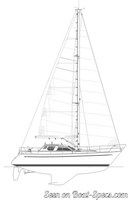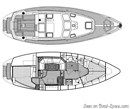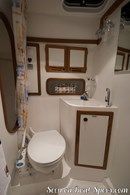Nauticat 321 Standard
Sailboat specifications
The Nauticat 321 is a 32’10” (10m) motorsailer designed by Siltala Design Office (Finland). She was built between 1999 and 2018 by Nauticat Yachts (Finland).
The Nauticat 321 is as well listed, on Boat-Specs.com, in Shoal draft and Deep draft version (see all the versions compared).
The Nauticat 321 is as well listed, on Boat-Specs.com, in Shoal draft and Deep draft version (see all the versions compared).
Nauticat 321's main features
- Model
- Nauticat 321
- Version
- Standard
- Hull type
- Monohull
- Category
- Deck saloon motorsailer
- Sailboat builder
- Sailboat designer
- Sailboat range
- Country
- Finland
- Construction
- GRP (glass reinforced polyester):
- Hull: Single skin fiberglass polyester
- Deck: Sandwich fiberglass polyester - First built hull
- 1999
- Last built hull
- 2018
- Appendages
- Keel : L-shaped keel (with bulb)
- Helm
- Twin helm wheels
- Rudder
- Single semi-spade rudder
- Unsinkable
- No
- Trailerable
- No
- EC design categoryiThe CE design category indicates the ability to cope with certain weather conditions (the sailboat is designed for these conditions)
A: Wind < force 9, Waves < 10m
B: Wind < force 8, Waves < 8m
C: Wind < force 6, Waves < 4m
D: Wind < force 4, Waves < 0,5m - A
- Standard public price ex. VAT (indicative only)
- About198 000 €(2017)
Nauticat 321's main dimensions
- Hull length
- 32’ 10”10 m
- Waterline length
- 27’ 2”8.3 m
- Beam (width)
- 10’ 7”3.24 m
- Draft
- 5’ 5”1.65 m
- Mast height from DWL
- 45’ 4”13.8 m
- Light displacement (MLC)
- 13669 lb6200 kg
- Ballast weight
- 4409 lb2000 kg
- Ballast type
- Lead
Nauticat 321's rig and sails
- Upwind sail area
- 576 ft²53.5 m²
- Downwind sail area
- 1101 ft²102.3 m²
- Mainsail area
- 240 ft²22.3 m²
- Genoa area
- 336 ft²31.2 m²
- Jib area
- 203 ft²18.9 m²
- Stormjib area
- 65 ft²6 m²
- Symmetric spinnaker area
- 861 ft²80 m²
- Rigging type
- Sloop Marconi masthead
- Mast configuration
- Deck stepped mast
- Rotating spars
- No
- Number of levels of spreaders
- 2
- Spreaders angle
- Swept-back
- Spars construction
- Aluminum spars
Nauticat 321's performances
- Upwind sail area to displacementiThe ratio sail area to displacement is obtained by dividing the sail area by the boat's displaced volume to the power two-thirds.
The ratio sail area to displacement can be used to compare the relative sail plan of different sailboats no matter what their size.
Upwind: under 18 the ratio indicates a cruise oriented sailboat with limited performances especially in light wind, while over 25 it indicates a fast sailboat. - 171 ft²/T15.85 m²/T
- Downwind sail area to displacementiThe ratio sail area to displacement is obtained by dividing the sail area by the boat's displaced volume to the power two-thirds.
The ratio sail area to displacement can be used to compare the relative sail plan of different sailboats no matter what their size. - 326 ft²/T30.31 m²/T
- Displacement-length ratio (DLR)iThe Displacement Length Ratio (DLR) is a figure that points out the boat's weight compared to its waterline length. The DLR is obtained by dividing the boat's displacement in tons by the cube of one one-hundredth of the waterline length (in feet).
The DLR can be used to compare the relative mass of different sailboats no matter what their length:
a DLR less than 180 is indicative of a really light sailboat (race boat made for planning), while a DLR greater than 300 is indicative of a heavy cruising sailboat. - 307
- Ballast ratioiThe Ballast ratio is an indicator of stability; it is obtained by dividing the boat's displacement by the mass of the ballast. Since the stability depends also of the hull shapes and the position of the center of gravity, only the boats with similar ballast arrangements and hull shapes should be compared.
The higher the ballast ratio is, the greater is the stability. - 32 %
- Critical hull speediAs a ship moves in the water, it creates standing waves that oppose its movement. This effect increases dramatically the resistance when the boat reaches a speed-length ratio (speed-length ratio is the ratio between the speed in knots and the square root of the waterline length in feet) of about 1.2 (corresponding to a Froude Number of 0.35) . This very sharp rise in resistance, between speed-length ratio of 1.2 to 1.5, is insurmountable for heavy sailboats and so becomes an apparent barrier. This leads to the concept of "hull speed".
The hull speed is obtained by multiplying the square root of the waterline length (in feet) by 1.34. - 6.99 knots
Nauticat 321's auxiliary engine
- Engine(s)
- 1 inboard engine
- Engine(s) power
- 39 HP
- Fuel type
- Diesel
- Fuel tank capacity
- 66 gal250 liters
Nauticat 321's accommodations and layout
- Cockpit
- Closed aft cockpit
- Cabin(s)
- 2
- Berth(s) (min./max.)
- 4 / 6
- Head(s)
- 1
- Freshwater tank capacity
- 116.2 gal440 liters
- Fridge/ice-box capacity
- 26.4 gal100 liters
- Maximum headroom
- 6’ 2”1.9 m
Nauticat 321's saloon
- Maximum headroom
- 6’ 2”1.9 m
Nauticat 321's fore cabin
- Berth length
- 6’1.83 m


Nauticat Yachts Nauticat 321 - - 1/15
Picture extracted from the commercial documentation © Nauticat Yachts
Picture extracted from the commercial documentation © Nauticat Yachts


Nauticat Yachts Nauticat 321 sailplan - - 2/15
Picture extracted from the commercial documentation © Nauticat Yachts
Picture extracted from the commercial documentation © Nauticat Yachts


Nauticat Yachts Nauticat 321 layout - - 3/15
Picture extracted from the commercial documentation © Nauticat Yachts
Picture extracted from the commercial documentation © Nauticat Yachts


Nauticat Yachts Nauticat 321 sailing - - 4/15
Picture extracted from the commercial documentation © Nauticat Yachts
Picture extracted from the commercial documentation © Nauticat Yachts


Nauticat Yachts Nauticat 321 sailing - - 5/15
Picture extracted from the commercial documentation © Nauticat Yachts
Picture extracted from the commercial documentation © Nauticat Yachts


Nauticat Yachts Nauticat 321 sailing - - 6/15
Picture extracted from the commercial documentation © Nauticat Yachts
Picture extracted from the commercial documentation © Nauticat Yachts


Nauticat Yachts Nauticat 321 sailing - - 7/15
Picture extracted from the commercial documentation © Nauticat Yachts
Picture extracted from the commercial documentation © Nauticat Yachts


Nauticat Yachts Nauticat 321 cockpit - - 8/15
Picture extracted from the commercial documentation © Nauticat Yachts
Picture extracted from the commercial documentation © Nauticat Yachts


Nauticat Yachts Nauticat 321 interior and accommodations - - 9/15
Picture extracted from the commercial documentation © Nauticat Yachts
Picture extracted from the commercial documentation © Nauticat Yachts


Nauticat Yachts Nauticat 321 interior and accommodations - - 10/15
Picture extracted from the commercial documentation © Nauticat Yachts
Picture extracted from the commercial documentation © Nauticat Yachts


Nauticat Yachts Nauticat 321 interior and accommodations - - 11/15
Picture extracted from the commercial documentation © Nauticat Yachts
Picture extracted from the commercial documentation © Nauticat Yachts


Nauticat Yachts Nauticat 321 interior and accommodations - - 12/15
Picture extracted from the commercial documentation © Nauticat Yachts
Picture extracted from the commercial documentation © Nauticat Yachts


Nauticat Yachts Nauticat 321 interior and accommodations - - 13/15
Picture extracted from the commercial documentation © Nauticat Yachts
Picture extracted from the commercial documentation © Nauticat Yachts


Nauticat Yachts Nauticat 321 interior and accommodations - - 14/15
Picture extracted from the commercial documentation © Nauticat Yachts
Picture extracted from the commercial documentation © Nauticat Yachts


Nauticat Yachts Nauticat 321 interior and accommodations - - 15/15
Picture extracted from the commercial documentation © Nauticat Yachts
Picture extracted from the commercial documentation © Nauticat Yachts
Similar sailboats that may interest you:
Sailboats
First built hull
Hull length
2005
31’ 7”9.62 m
1990
33’ 8”10.28 m
1974
33’ 6”10.2 m
2015
32’9.75 m
1985
28’ 11”8.8 m
1971
30’9.14 m
1999
31’ 1”9.49 m
1981
28’ 11”8.8 m
2010
32’9.75 m
1996
32’ 2”9.8 m
1989
32’ 8”9.98 m
1999
32’ 10”10 m
1967
33’ 1”10.1 m
1980
33’ 11”10.34 m
2006
34’ 10”10.6 m